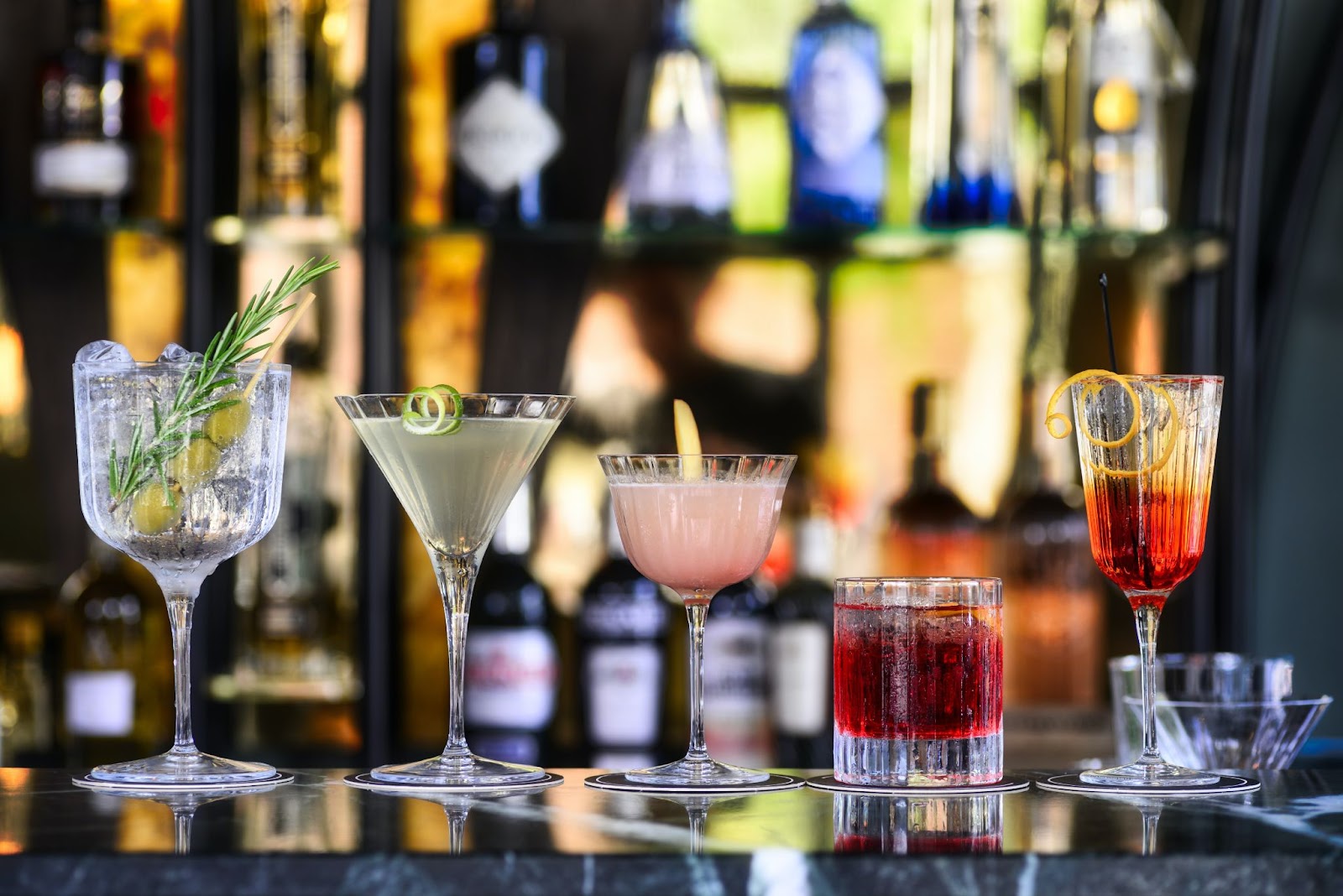
Certain cocktails benefit from a wide range of glasses that enhance both their appearance and taste. Picking the right drinkware boosts a beverage’s aroma and temperature. All this means that using the right cocktail glass is incredibly important.
But what type of glass does your bartender need for some of the most common cocktails on your bar’s menu?
Read on to learn about the most common types of cocktail glasses and how their design brings out different aspects of each beverage.
What We’ll Cover in This Piece:
Why Are Certain Cocktails Served In Certain Glasses?

Photo by Stanislav Ivanitskiy on Unsplash
Developed in order to improve a drink’s appearance and flavor, appropriate cocktail drinkware accentuates aromas and regulates temperature.
Both contribute to showcasing the cocktail recipe in its intended form. And at the end of the day as a bar or restaurant owner, that should be top of mind for you, creating a more memorable drinking experience.
Once you familiarize yourself with cocktail glasses, get some inspiration from our well guide along with 15 unique cocktails to make.
Martini Glass

Photo by Aditya Saxena on Unsplash
The chalice-like design of the martini glass forces you to sip your drink, making it perfect for drinks without mixers. Or for adding a toothpick with a row of olives across the top. The traditional martini glass holds about 4 to 4.5oz.
Classic cocktails to serve in a martini glass include:
- Martini
- Cosmopolitan
Rocks Glass

Photo by Daniel Herron on Unsplash
Wide and short with a thick base, rocks glasses, also known as old-fashioned or lowball glasses, hold between 6 to 8oz of liquid. Because of the shape of the glass, rocks encourage bartenders to muddle ingredients, stir, and add large chunks of ice. Hence on the rocks, which in the cocktail world literally means a drink served undiluted with ice cubes.
For that reason, rocks glasses predominantly hold spirit-based drinks, unlike their counterparts, which contain more ice and mixers.
Classic cocktails to serve in a rocks glass include:
- Old Fashioned
- Negroni
Margarita Glass

Photo by Hybrid Storytellers on Unsplash
Identified by its large, round bowl, the margarita glass also has a distinctive wide rim that allows for ample garnishes. Both play a large role in this glass. The bowl enhances the aroma of the drink, while the broad rim provides room for that characteristic salty or sugary component.
Additionally, the tall stem makes the glass easy to grasp even on the largest sizes.
Classic cocktails to serve in a margarita glass include:
- Frozen Margarita
- Daiquiri
Highball/Collins Glass

Photo by wu yi on Unsplash
This long, straight glass holds 8 to 12oz of ice and is suitable for serving rock cocktails. Based on its narrow shape, a highball/Collins glass maintains the right temperature and carbonation for the cocktails traditionally served in them.
Because a highball glass is slightly shorter and wider than a Collins glass, it is frequently used interchangeably with one.
Classic cocktails to serve in a highball/Collins glass include:
- Rum and Coke
- Paloma
- Gin and Tonic
Copper Mug

Photo by Wine Dharma on Unsplash
The copper mug is excellent for keeping cold beverages cold on a hot day, thanks to its conductivity. Historically, the Moscow Mule cocktail, a vodka-ginger beer-lime juice mixture, has been served in copper mugs.
Copper is said to enhance the flavors of ginger beer and citrus as well as the fizziness. Although nowadays, many copper mugs are lined with stainless steel in order to prevent copper leaching into beverages.
Classic cocktails to serve in a copper mug:
- Moscow Mule
- Mint Julep
Coupe Glass

Photo by Ambitious Creative Co. – Rick Barrett on Unsplash
Originally created to accommodate champagne, the coupe glass’s round shape actually isn’t suited for fizzy beverages. The large surface area makes it difficult for bubbles to dissipate. Instead, a coupe glass is best suited for drinks that require straining and serving ‘straight up’ without ice, such as a Manhattan.
This glass has a very long stem, which prevents your hand from warming the drink.
Classic cocktails to serve in a coupe glass include:
- Manhattan
- Gimlet
Other Content You May Enjoy
To succeed and grow your restaurant, bar, or brewery you need to stand out in local search results. Whether someone is searching for the “best craft beer near me” or “top-rated seafood restaurant in [your city],” Local SEO (Search Engine Optimization) helps your business appear at the top of those search results.
With 81% of consumers using Google Search and Maps to find local businesses, and nearly 90% of customers choosing a business on the first page of search results, optimizing your online presence is essential.
This guide will walk you through Local SEO strategies tailored for restaurants, bars, and breweries, covering Google My Business, website optimization, online reviews, local backlinks, and more.
By the end of this guide, you’ll have a step-by-step action plan to increase your search rankings, attract more local customers, and grow your business.
In today’s digital world, having a well-designed, functional website is essential for restaurants, bars, and breweries. It goes beyond having social media. A great website can help attract new customers, showcase menus, accept reservations, and even drive online sales. But one of the most common questions business owners ask is: How much should a website cost in 2025?
The answer depends on several factors, including the type of website, features, complexity, and whether you choose a DIY solution or hire a professional web developer. Costs can range from a few hundred dollars for a basic website to tens of thousands for a fully customized, feature-rich platform.
This guide will break down website costs for restaurants, bars, and breweries, helping you understand the pricing landscape and choose the best solution for your business
Trivia nights have become an incredible marketing strategy for bars, restaurants, and breweries to draw in crowds and engage with new customers. With the recent collaboration between Geeks Who Drink, Timeplay, and the iconic television show Jeopardy!, businesses now have an exciting opportunity to host the Jeopardy! Bar League. This partnership combines the global brand recognition of Jeopardy! with Timeplay’s cutting-edge technology and the fun of live trivia from the experts at Geeks Who Drink.
In this piece we’ll cover what this new collaboration between these two trivia powerhouses is and how you can bring this unique experience to your venue.
In today’s world, both websites and social media platforms are crucial for a brewery, bar, or restaurant’s online presence. However, consumer habits show distinct preferences for each, depending on the context of their search or interaction.
In this guide, we’ll go over the basics, walk you through how to leverage these tools effectively, and show you how understanding these trends can help your venue better meet your customers’ expectations.
As a restaurant, bar, brewery, or any venue with a food and beverage program, having a modern, functional, and aesthetically pleasing website isn’t just a luxury—it’s a necessity.
No matter the size of your business, your new potential customers often interact with your website first—and first impressions matter.
In this piece, we’ll explore the top website trends shaping the online presence of hospitality businesses in 2025. These trends will help your venue stand out and attract more customers while creating a unique and modern experience to establish the perfect guest experience from start to finish.
For bar owners, hospitality managers, and small business owners, selecting the right gin brands is more than just filling the shelves—it’s about curating a distinctive customer experience. Gin has soared in popularity, becoming a staple of modern cocktail culture. With its complex botanical infusions, gin offers versatile, memorable flavors that can attract a wide range of customers. But with so many choices available, which brands should you prioritize to bring out the best in your gin menu?
This guide explores the seven best gin brands that have proven themselves through quality, craftsmanship, and unique flavor profiles. By understanding what makes each brand special, you and your staff will be better equipped to create a standout gin selection that delights your patrons, reinforces your brand’s reputation with a robust gin drinks menu, and helps you continue crafting classic and innovative gin cocktails.

